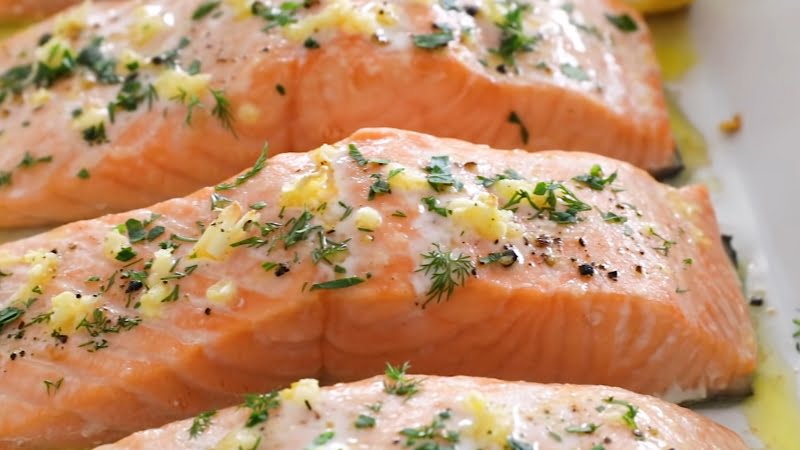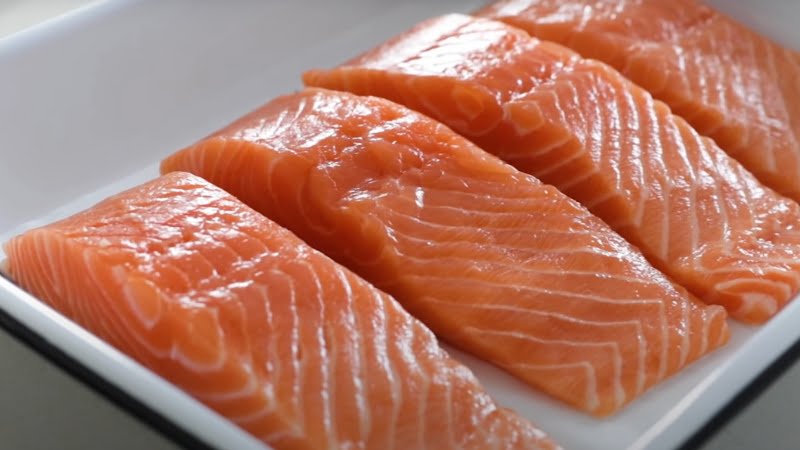For a simple yet elegant main course, few options rival baked salmon fillets. This cooking method requires minimal effort, as baking salmon in the oven is largely hands-off.
With our easy-to-follow instructions, you’ll learn how to cook salmon at 425 degrees in your oven. This common oven temperature helps the salmon cook perfectly, staying juicy and flavorful.
Salmon is one of my favorite proteins to cook and eat. It’s delicious, good for you, and bakes up beautifully in the oven. While there are many different ways to prepare salmon, baking it is one of the easiest and most foolproof methods.
When baking salmon, there are a few key things to keep in mind for perfect results every time preheating your oven using the right temperature, monitoring doneness, and avoiding overcooking. In this article I’ll share my tips on how long you should bake salmon fillets at 425°F to emerge from the oven moist, flaky, and delicious.
Why Bake Salmon at 425°F?
425°F is a great temperature for baking salmon. It’s high enough to crisp up the outside and make the fatty skin look great, while still cooking the inside slowly. Because salmon has a fair amount of fat, it can handle higher oven temperatures as long as it doesn’t get too done.
Lower oven temperatures, like 350°F, would mean less browning on the outside, more soggy skin, and longer cooking times, which makes it more likely that the meat will dry out.
When the temperature is above 425°F, cooking goes too quickly, making it easier to overbake the fish.
So 425°F hits that sweet spot allowing you to achieve
- A crispy, browned exterior with rendered, fatty, delicious skin
- Moist, tender, flaky flesh inside
Without the hassle of babysitting it in the oven for ages.
How Long to Bake Salmon Per Inch of Thickness
The most important factor determining salmon’s cooking time is its thickness.
Here’s a general guideline:
At 425°F, bake salmon for 4-6 minutes per 1/2 inch of thickness.
For example:
- 1/2 inch thick fillet = bake for 6-9 minutes
- 1 inch thick fillet = bake for 12-15 minutes
- 1 1/2 inch thick fillet = bake for 18-22 minutes
This produces salmon with the ideal interior doneness while avoiding overcooking.
Salmon fillets are typically sold in 1 pound portions, containing two 6-8 ounce fillets that are about 1 inch thick in the thickest part. For these average sized, 1-inch thick fillets, bake at 425°F for 12-15 minutes.
However, it’s important to note that cooking times can vary a bit depending on factors like:
- Your oven’s true temperature (some run hot or cool)
- Whether the salmon is skin-on or skinless
- If the fillets are fattier or thinner at one end
- If the fish was previously frozen
That’s why I always rely on a digital thermometer to check for doneness when baking salmon. It takes the guesswork out of determining if the fish is cooked through.
How to Tell When Salmon is Done
Using an instant read thermometer is hands down the easiest way to check for doneness. Salmon is perfectly cooked at an internal temperature of 125°F-130°F.
If you don’t have a thermometer, you can check for doneness by slicing into the thickest part of the fillet and looking inside. Properly cooked salmon will be opaque and slightly translucent inside. It should flake easily with a fork but still be moist.
Undercooked salmon will have an overly glassy, translucent appearance inside. Overcooked salmon will be chalky and dry inside, with opaque white protein coagulating on the surface.
Peeking inside the thickest portion lets you judge doneness while keeping most of the fillet intact.
Common Mistakes and How to Avoid Them
Salmon is easy to bake, but there are a few pitfalls that can lead to dry, overcooked fish:
Not Preheating the Oven
It’s crucial to fully preheat your oven before baking salmon. If you put the fish into a cold or warming oven, it will throw off cook times and lead to unevenly cooked fish.
Baking Too Long
It can be tempting to just leave the salmon in the oven for 20+ minutes without checking it. But this dramatically increases the odds of overbaking. Rely on thickness guidelines and use a thermometer to prevent overcooking.
Baking Thick and Thin Pieces Together
Salmon fillets often taper, with one end thicker than the other. If you bake a thin end alongside a thick end, the thin part will dry out while the thick part is underdone. For even cooking, fold under or trim thin ends.
Cooking From Frozen
Never bake salmon straight from frozen at 425°F unless the fillets are very thin (less than 3/4 inch). Frozen salmon releases a lot of liquid as it thaws, steaming the fish. Defrost first for best results.
Using Oven Temps Above 425°F
Higher heat leads to faster overcooking. 425°F is hot enough to brown and crisp the fish. Higher temps create too large of a gap between perfectly cooked and overcooked salmon.
Cooking Tips for Moist, Flaky Salmon
Here are a few of my top tips for baked salmon with a tender, silky interior:
-
Use nonstick foil or cooking spray – This prevents sticking and allows you to gently release the fish after cooking.
-
Brush with oil – Coating the salmon with olive oil or melted butter helps it develop a nice crust while sealing in moisture.
-
Dry brine – Sprinkling the salmon with salt and letting it sit for 15-20 minutes before baking seasons the fish and keeps it juicy.
-
Temp and check for doneness – Monitor thickness, preheat your oven, and use a thermometer for best results.
-
Rest before serving – Let the salmon sit off heat for 5 minutes after baking so juices redistribute through the flesh.
My Favorite Go-To Baked Salmon Recipes
While plain baked salmon is delicious, I also love to add flavor with spices, citrus, garlic, herbs, and other ingredients. Here are two of my favorite baked salmon recipes:
The lemon brightens up the rich salmon beautifully. I use fresh thyme for its woodsy herbal flavor, but dried thyme works too.
Baked Salmon with Garlic Butter
Topping the salmon with savory, garlicky butter makes it even more moist and flavorful. This recipe always gets rave reviews.

How Long To Bake Salmon At 425 Degrees
Ten to twelve minutes for every inch of thickness is the best time to bake a salmon fillet in the oven at 425 degrees Fahrenheit. This rule will help you get a delicious baked salmon cooked just right.
But remember that the exact baking time can change a bit. It can depend on the thickness of the salmon and if your oven heats evenly. So, always check your salmon to make sure it’s done.

You may need to bake the salmon for a few more minutes if you’re using foil. This is because wrapping the salmon in foil keeps the heat from getting to the fish as quickly. But don’t worry – it’s easy to do. Just wrap your salmon in foil, then bake it in the oven at 425°f for 15-20 minutes.
If you’re cooking frozen salmon, you can still bake it at 425 degrees Fahrenheit. But you’ll need to add more time. It can take around 20-25 minutes to bake a frozen salmon fillet at 425 degrees.
And finally, how do you know when the salmon is done? A cooking thermometer is the best way to find out. When it reads 145 degrees Fahrenheit, your salmon is cooked perfectly. Salmon should be opaque (not see-through) and easy to flake with a fork if you don’t have a thermometer.
Tips For Ensuring Moist And Flavorful Salmon
It might seem hard to cook salmon just right, but don’t worry! Here are some simple tips that will help you always get moist and tasty salmon when you bake it.
- Before you start cooking, always heat the oven up to 425 degrees Fahrenheit. This makes sure that the oven is hot enough when you put the salmon in it, so it cooks even.
- To find out how long your salmon needs to cook, look at how thick the fillet is. As a general rule, salmon should be baked for 10 to 12 minutes for every inch of thickness. This helps you avoid under or overcooking.
- Season Well: Don’t forget to season your salmon before cooking. Just adding salt, pepper, and a squeeze of lemon can change the taste of food.
- Avoid Overcooking: Overcooked salmon can turn dry. To keep your salmon from drying out, cook it until it reaches 145 degrees Fahrenheit on the inside. This is when it’s just right!.
- How to Store It: If you have leftover baked salmon, put it in a container that won’t let air in before putting it in the fridge. This keeps the salmon for your next meal fresh and tasty.
If you remember these tips, you’ll know exactly how long to bake salmon at 425 degrees so that it comes out juicy and delicious.

How long to cook salmon in oven at 425?
FAQ
How long do you cook salmon at 425?
What is the best temperature and time to cook salmon?
How long to cook salmon from frozen 425?
When baking salmon, do you flip it?
